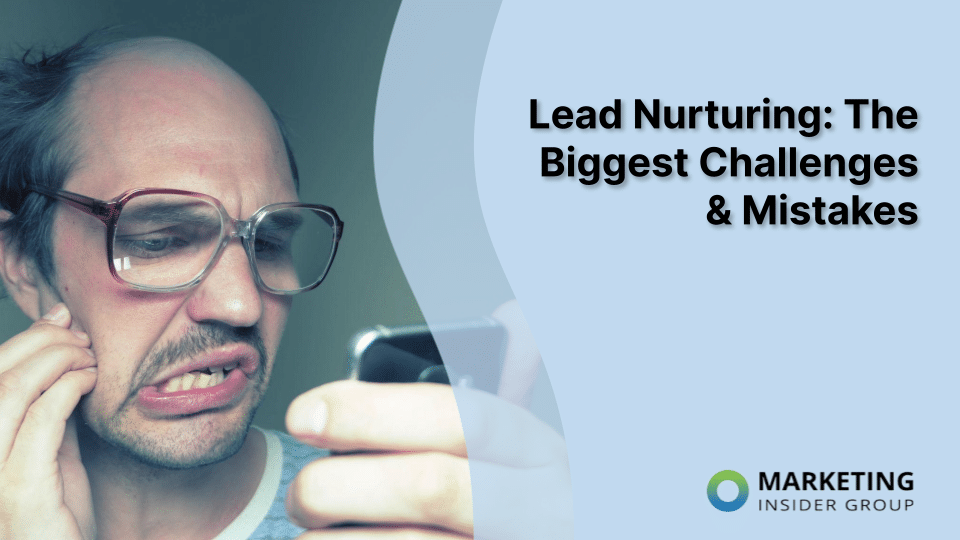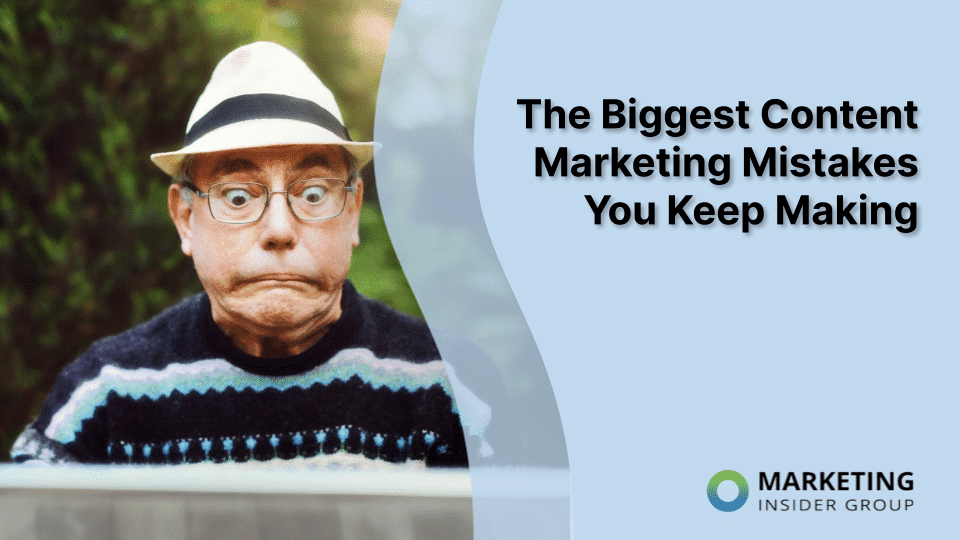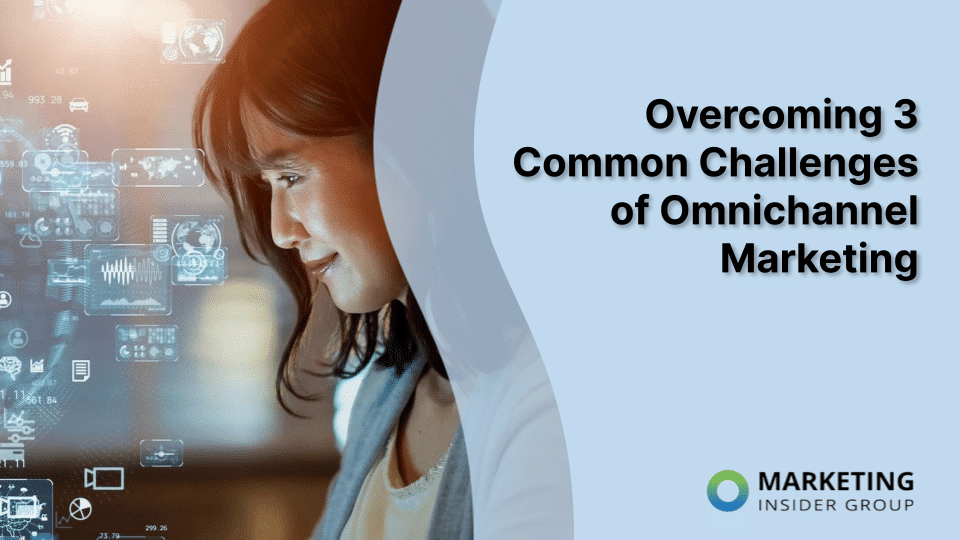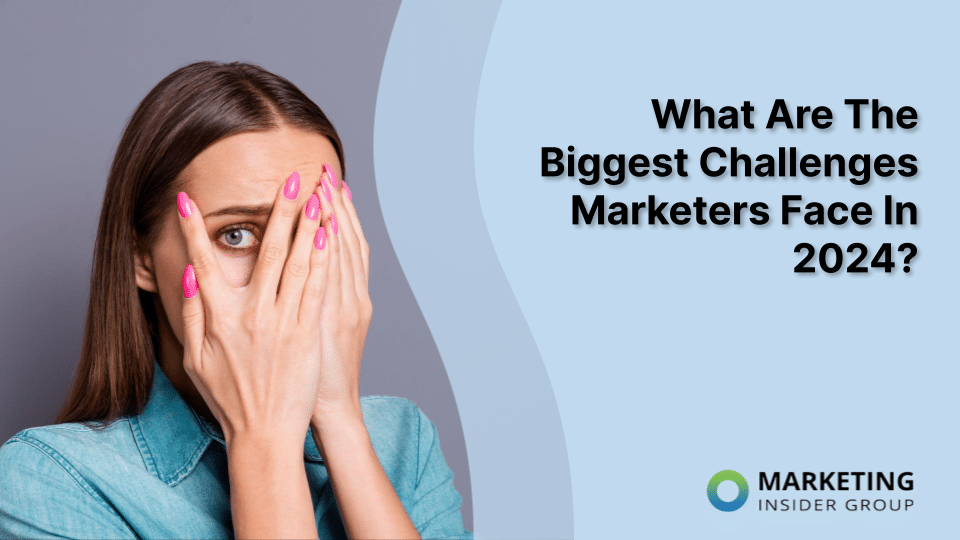
What Are The Biggest Challenges Marketers Face In 2024?
Navigating the marketing landscape in 2024 presents a unique set of challenges, but with the right insights and strategies, overcoming them is within reach. Marketing Insider Group’s team of experts asked OpenAI’s ChatGPT to identify the most pressing marketing challenges of 2024, and we’re ready to tackle them.
Our goal? To equip you with the knowledge and tools needed for a highly productive year ahead.
Quick Takeaways:
- Embracing emerging technologies such as augmented reality (AR), virtual reality (VR), and blockchain is essential for creating immersive and interactive consumer experiences.
- Over 50% of searches will be voice searches by 2025, so optimizing for voice search is becoming increasingly important, requiring a shift in keyword strategy.
- Diversifying marketing channels is essential to mitigate risks associated with reliance on a single platform.
- The delicate dance of balancing personalization with privacy concerns continues to evolve, especially in light of regulations like GDPR and CCPA.
- Recognizing sustainability and ethical marketing as critical consumer expectations, not merely trends, is vital for maintaining brand loyalty as consumers increasingly make purchases that align with their values.
Are you prepared to steer your business through these challenges? We’ve dug deep and used our expertise to provide actionable insights and solutions, helping you not only understand but also effectively tackle these hurdles. Let’s dive in:
What Are 2024’s Biggest Marketing Challenges?
The US artificial intelligence market is expected to reach almost $600 billion by 2027. This means that the sooner professional marketers learn about these tools, the better we can utilize their technology to improve our businesses.
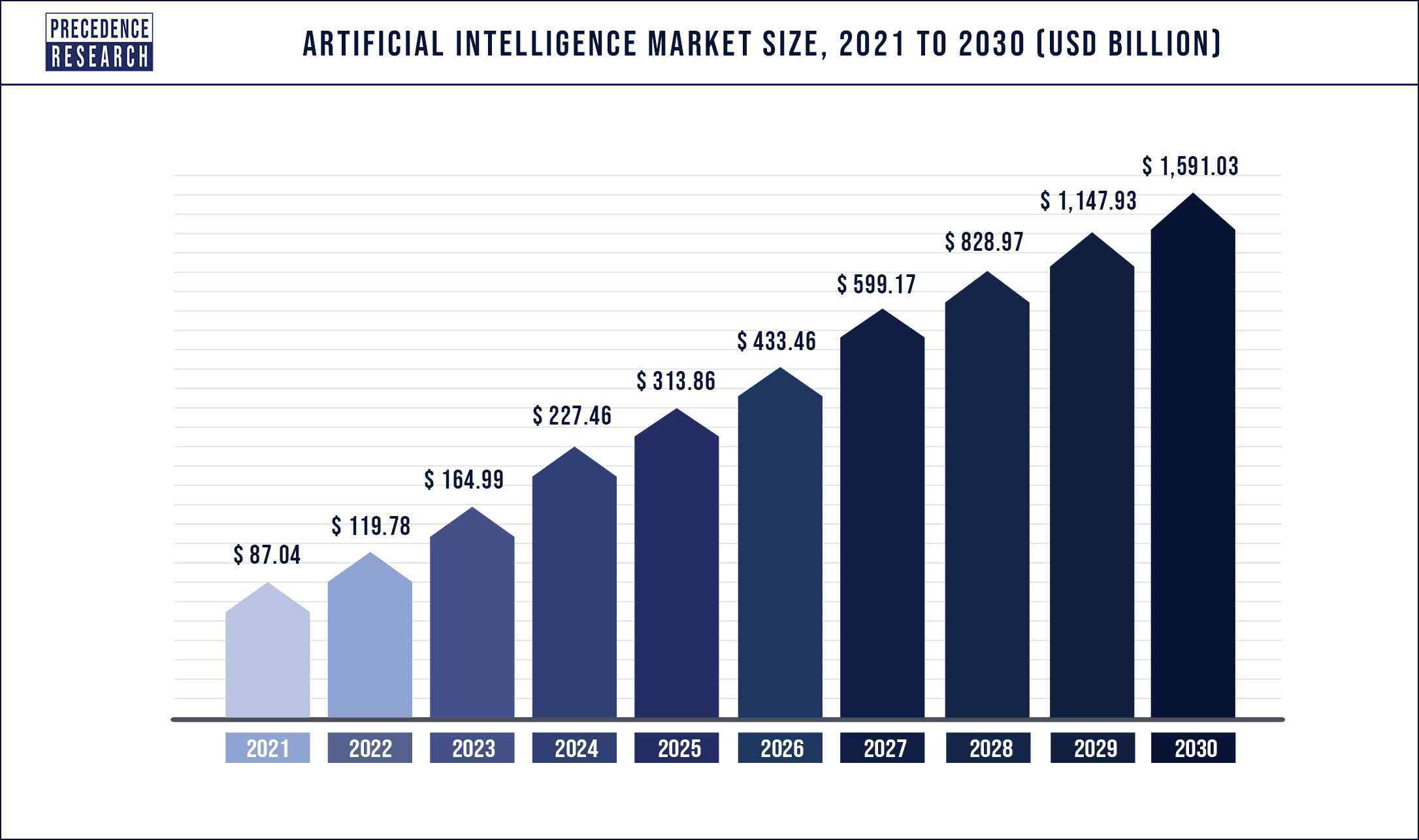
Image Source: Precedence Research
That being said, we don’t see AI as a challenge here at MIG, but rather an opportunity. So we decided to ask Open Ai’s ChatGPT to help us answer the question we’re all dying to know: What are the biggest challenges marketers will face in 2024?
Although it can be difficult to pinpoint specific challenges that marketers will face in the upcoming year, ChatGPT predicts that the most likely potential challenges include:
- Increasing competition: With the rapid growth of digital platforms and increased ease of distributing content online, businesses are experiencing increased difficulty when it comes to standing out in the crowded digital landscape.
- Changing consumer behavior: As people become more dependent on technology, consumer behavior and expectations are expected to shift.
- Personalization and privacy: With increased use of personalization and targeting in marketing, both businesses and consumers share concerns about data privacy and the ethical consequences of using consumer data.
- Voice search optimization: With the rise of smart speakers and voice assistants, optimizing for voice search will become more important.
- Diversifying marketing channels: Relying solely on one platform or channel can be risky, so marketers will need to diversify their strategies.
- Dealing with ad blockers: As more consumers use ad blockers, finding ways to reach audiences without being intrusive will be crucial.
- Sustainability and ethical marketing: As consumers become more conscious of environmental and social issues, marketers will need to ensure their campaigns reflect these values.
- Measuring effectiveness: As marketing channels and tactics continue to grow, marketers may struggle to accurately measure the effectiveness of their campaigns and allocate their resources properly.
- Adapting to new technologies: With emerging technologies like augmented reality, virtual reality, and blockchain, marketers will need to learn how to incorporate these into their strategies.
- Staying up-to-date: Being successful in the marketing field requires staying up-to-date on the latest marketing trends and developments. Marketers who have limited time and resources to dedicate to professional development may be challenged.
Now, we won’t leave you high and dry here! Let’s dive into some ways to alleviate and overcome these challenges.
2024’s Biggest Marketing Challenges and How To Overcome Them
Increasing Competition
As digital platforms continue to grow and content distribution becomes effortless, it’s not going to be easy to stand out in the crowd. As a successful marketer, you need to find ways to stay one step ahead of the competition.
Although it’s easier said than done, competition exists in every type of market. You can increase your business’s market share by using the following methods to nullify the effect of competitors:
- Solve Your Customers’ Problems. Connect with your target audience by asking open-ended questions and identify what exactly they’re looking for. Take the time to focus your efforts on providing solutions to their issues, instead of educating them on your products and services.
- Find Your Niche. Building a niche gives you a unique selling proposition, automatically minimizing the competition. Storytelling and specialization are great ways to promote the exclusive nature of your products and services, and set them apart from the competition.
- Set Competitive Pricing. Affordable pricing gives your business a competitive edge. Opt for a competition-based pricing strategy and analyze the average rate for your market offering. The market is separated into lower, middle and upper-tiered consumers; determine in which group your target audience falls before setting competitive prices.
- Excel in Customer Service. Memorable customer service builds loyalty among your consumers and makes you stand out from competition. Be sure that your employees are educated, motivated and rewarded to ensure they remain courteous, content and respectful when working with customers.
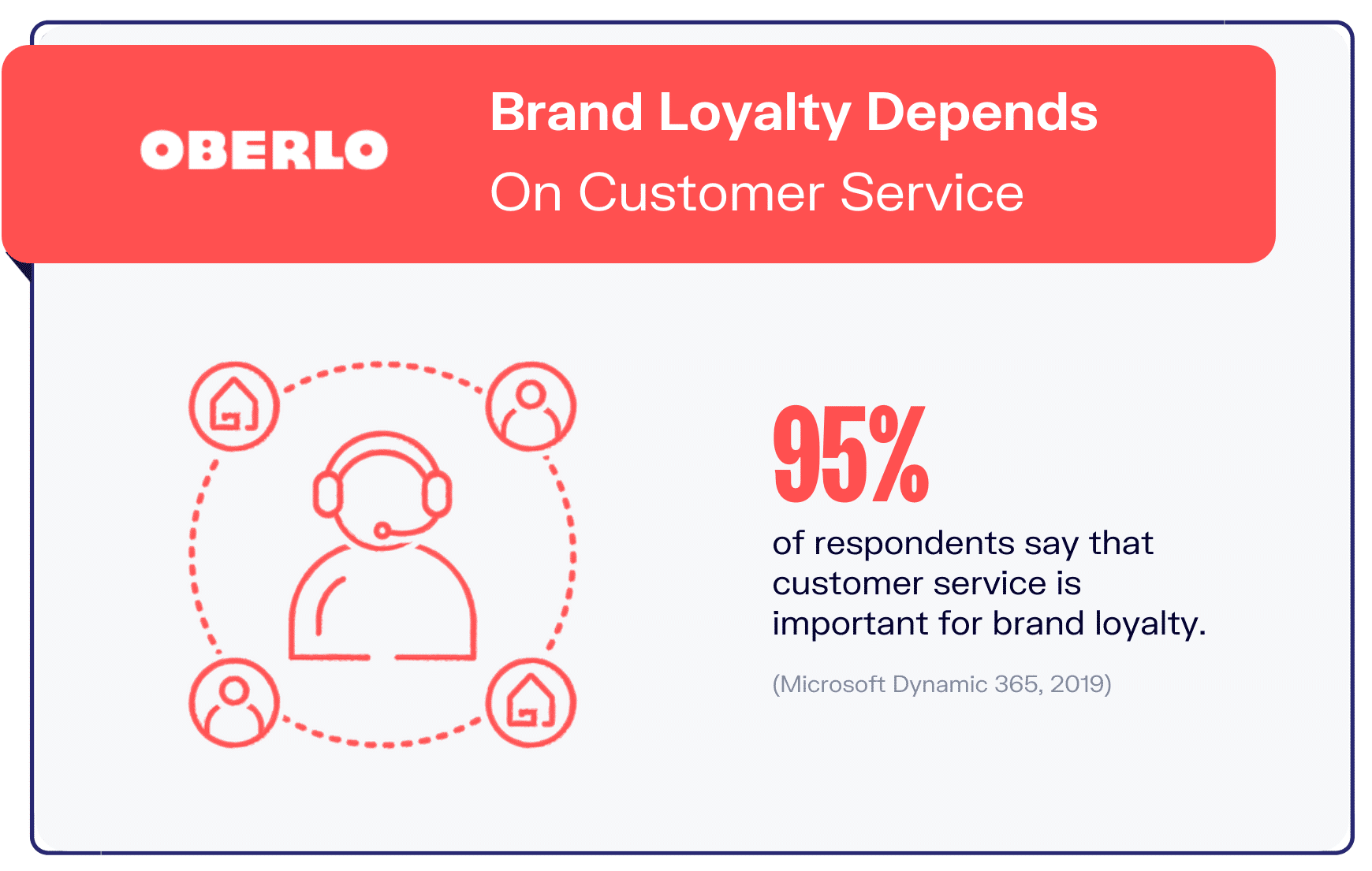
Image Source: Oberlo
There’s no simple solution to beating your competition, but implementing these four powerful strategies will keep your business ahead of the game.
Changing Consumer Behavior
Consumers are becoming increasingly reliant on technology (hello, AI!), ultimately causing a shift in their behavior and expectations. This requires marketers to adapt and find new ways to engage with their target audiences.
Your business’s online presence is an integral part of your brand’s success. Here are some tips for building a customer-first strategy that promotes long-term growth:
- Prioritize Customer Retention. Keeping your loyal customers satisfied is key to seeing continued growth. Create unique customer experiences by sending invites to your loyalty program, suggesting complimentary products or downloads, and asking for feedback. This keeps your target audience engaged and earns customer retention.
- Update Your Social Media. Social Media simplifies addressing concerns, suggestions and feedback. Diversify your customer interactions with conversational tools to satisfy your target audience’s needs. Demonstrating your business’s value and driving consumers towards conversion is easy with networks like Linkedin, Instagram and TikTok.
- Update Calls To Action. Being proactive about customer communication moves users along the buyers’ journey. Anticipate your target audience’s questions and make answers easily accessible on your website. Doing so will minimize cart abandonment and maximize your conversion rate.
When it comes to adjusting to changing consumer behavior, don’t be afraid to invest in your marketing channels. Taking the time to refine your brand’s image and building a loyal following will keep your business well-positioned to overcome shifts in the market.
Personalization and Privacy
Data privacy and the ethical repercussions of using consumer data has risen to the forefront of marketing concerns. In fact, 79% of people take action in at least one way to protect their data.
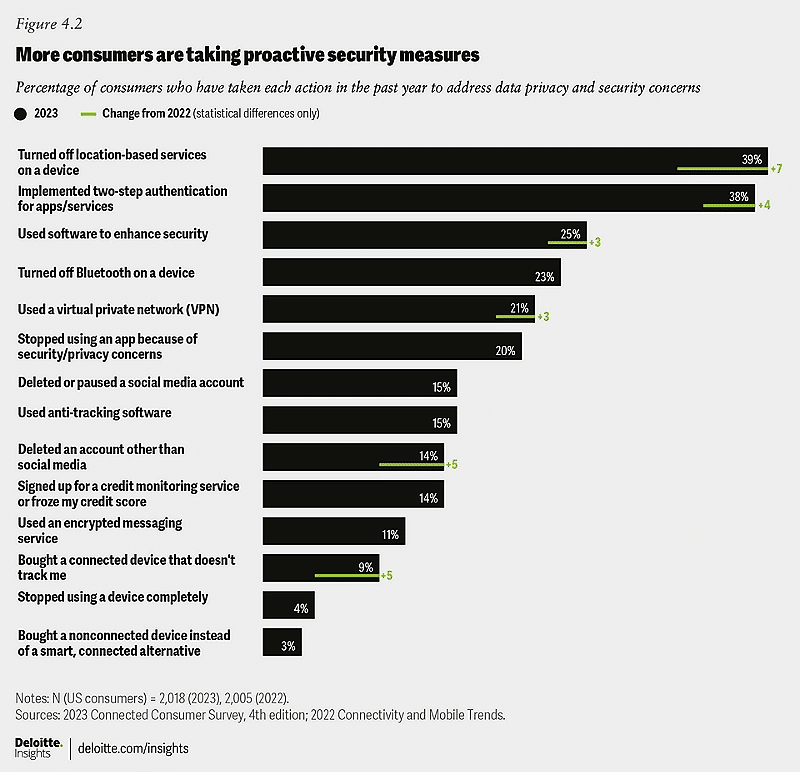
Image Source: Deloitte
While people are taking personal steps towards privacy, even those who haven’t caught on might be out of marketers reach soon. The digital marketing world has seen significant changes with the introduction of the General Data Protection Regulation (GDPR) in Europe and the California Consumer Privacy Act (CCPA) in the U.S. These regulations mandate:
- Transparency in Data Collection: Brands must clearly inform consumers about the data they collect and how it will be used.
- Consumer Rights Over Data: Consumers have the right to request access to their data, ask for corrections, and even demand deletion of their data.
- Strict Data Protection Measures: Organizations are required to have robust data protection mechanisms in place to prevent breaches and misuse.
We can anticipate similar regulations to continue developing. To overcome this industry challenge, professional marketers need to balance the benefits of personalized marketing with the need to protect consumer privacy. To do so, there are 3 main aspects to focus on:
- Build Trust. As more and more brands demand personal data, consumers have started to share their information more sparingly. Since 81% of consumers won’t share any personal data, building trust with your target audience is crucial to delivering a personalized experience.
- Communicate With Authenticity. Consumers respond best to authentic, simple and transparent communication. Powerful messaging and targeted language creates a memorable experience, encouraging customers to engage with a brand. According to BCG’s research, this strategy delivers an increase of more than 40% in conversion rates.
- Encourage Consumer Data Sharing. As the marketing landscape shifts, businesses should move away from receiving data through cookies, and instead through consumers’ voluntary sharing of personal information. Empower your audience to share data by demonstrating its purpose and value, such as customized content and experiences.
Personalization remains a great way for marketers to strengthen their relationships with consumers. Find the right balance between personalization and privacy by building trust, communicating with authenticity and empowering consumers to share personal data.
Voice Search Optimization
The proliferation of smart speakers, voice assistants, and voice-activated devices has ushered in a new era of search. As consumers increasingly turn to voice commands to find information, shop, and interact with brands, optimizing for voice search has become a critical component of modern marketing strategies.
27% of all searches in the Google App are done via voice. This number is only predicted to increase each year. This shift is driven by the convenience and hands-free nature of voice commands, especially in scenarios like driving or multitasking.
Voice searches exhibit distinct characteristics that set them apart from traditional typed queries. For one, they tend to be more conversational, often extending longer than their typed counterparts. This conversational nature necessitates a shift in keyword strategy, emphasizing natural language phrases that align with how people speak.
A significant portion of voice searches are rooted in local intent as well. Queries like “Where’s the nearest coffee shop?” are commonplace, underscoring the importance for brands to bolster their local SEO efforts to effectively capture these searches.
The immediacy of voice search cannot be overlooked either. Users often turn to voice search for quick, on-the-spot answers. As a result, brands are tasked with delivering concise and relevant content that voice assistants can relay to users without delay.
So, how can marketers adapt? Here are a few strategies for success:
- Use Structured Data. Ensuring your website uses structured data can help voice search algorithms understand and prioritize your content.
- Utilize FAQs. Incorporating frequently asked questions in a conversational tone can capture more voice search traffic.
- Stay Updated. Voice search algorithms and technologies are constantly evolving. Brands should stay updated on the latest trends and best practices in voice search optimization.
Diversifying Marketing Channels
In an ever-evolving digital landscape, relying solely on one platform or marketing channel can be a precarious strategy. Algorithm changes, platform policies, or shifts in user behavior can drastically impact a brand’s visibility and engagement.
Those that heavily invest in just one platform may find themselves at a disadvantage, especially if the platform’s rules undergo changes or if it loses its appeal among its user base. However, diversification serves as more than just a protective measure against these uncertainties; it’s a strategic approach to growth.
By branching out across various platforms, brands have the opportunity to engage with a broader audience, given that different platforms often cater to distinct demographics. This diversified approach also offers a safety net, ensuring that if one channel faces challenges or underperforms, others can step in to maintain consistent engagement and reach.
Diversification also paves the way for experimentation. Brands can explore different strategies and content types across platforms, fostering a culture of innovation and adaptability.
Here are a few ways to succeed in platform diversification:
- Analyze Your Audience. Understand where your target audience spends their time online and prioritize those channels.
- Maintain Consistent Branding. While the content might vary across channels, ensure consistent branding and messaging.
- Monitor and Adapt. Regularly review the performance of each channel and be ready to adapt your strategy based on results and emerging trends.
Dealing with Ad Blockers
The rise in the use of ad blockers reflects a growing desire among consumers for a more streamlined and less intrusive online experience. With pop-ups, auto-play videos, and banner ads often seen as disruptive, over 42% of users have turned to ad blockers to enhance their browsing experience.

Image Source: Backlinko
This creates some unique challenges for marketers:
- Lost Revenue. For businesses that rely heavily on ad revenue, ad blockers can significantly impact profitability.
- Limited Reach. Even the most well-crafted ad campaign can fall flat if a substantial portion of the target audience uses ad blockers.
- Consumer Perception. The increasing use of ad blockers indicates a broader sentiment among consumers – many find online ads disruptive, irrelevant, or untrustworthy.
To combat these challenges, there are a few strategies marketers can adopt:
- Content Marketing. Instead of relying solely on traditional ads, brands can create valuable, engaging content that consumers actively seek out. Blogs, videos, podcasts, and other forms of content can draw in audiences without the need for intrusive ads.
- Native Advertising. Ads that blend seamlessly with the platform they’re on (like sponsored posts on social media or advertorials) can bypass ad blockers and are often viewed more favorably by consumers.
- Building Relationships. Encouraging users to whitelist your site or subscribe to newsletters can help maintain a direct line of communication. Offering exclusive content or other incentives can make this proposition more appealing.
- Transparency and Communication. Informing users about how ad revenue supports the content they enjoy can encourage some to disable their ad blockers. Being open about your site’s ad practices can build trust and understanding with your audience.
In an era where consumers have more control over their online experiences than ever before, marketers must be agile and innovative. By understanding the reasons behind the rise of ad blockers and adapting strategies accordingly, brands can continue to connect with their audiences in meaningful ways.
Sustainability and Ethical Marketing
As global awareness of environmental and social issues continues to grow, consumers are increasingly aligning their purchasing decisions with their values. Brands that fail to recognize this shift risk not only falling out of favor but also missing out on a significant opportunity to connect on a deeper level with their audience.
Today’s consumers are more informed than ever, often taking the time to research a brand’s ethical practices and sustainability efforts before making a purchase. This heightened awareness is not just about making informed choices; it also translates to tangible shifts in purchasing behavior.
66% of consumers are willing to pay a premium for products from brands that demonstrate a commitment to positive social and environmental impact. Furthermore, ethical practices can lead to increased brand loyalty, with consumers more likely to remain faithful to brands that align with their values.
Looking ahead, there are a few means of navigating the heightened ethical landscape of marketing in 2024:
- Transparency. Brands should be open about their sourcing, manufacturing, and other processes, providing consumers with the information they need to make informed decisions.
- Authenticity. It’s not enough to just talk about sustainability and ethics; brands must walk the walk. Token gestures or “greenwashing” can lead to backlash and damage a brand’s reputation.
- Engagement. Engaging with consumers on issues they care about, whether through social media campaigns, partnerships with NGOs, or other initiatives, can foster a deeper connection and trust.
- Storytelling. Share the brand’s journey towards sustainability and ethics, highlighting challenges, successes, and future goals.
- Certifications. Obtaining certifications from recognized bodies can provide third-party validation of a brand’s claims.
- Consumer Involvement. Involve consumers in the brand’s ethical journey, whether through feedback, collaborative projects, or other forms of engagement.
In a world where consumers are becoming more conscious and discerning, sustainability and ethical marketing are no longer optional. Brands that embrace these values and integrate them into their marketing strategies stand to benefit both in terms of reputation and bottom line.
Measuring Effectiveness
As marketing tactics continue to evolve, accurately measuring the success of campaigns and allocating resources effectively presents itself as a challenge. The key to ensuring reliable metrics is differentiating between tools that highlight potential vs. actual results.
For example, the following metrics only scratch the surface when it comes to measuring effectiveness:
- Followers
- Likes
- Impressions
- Clicks
Instead, accurately measure market performance by using data that helps analyze actual results:
- Revenue and sales
- Lead generation
- Customer retention
- Brand awareness
- Engagement
You can best understand the success of marketing campaigns and allocate resources properly by connecting your marketing strategy with data that represents or directly leads to increased revenue. To learn more about how to properly measure the effectiveness of your marketing strategy, enjoy the short video below.
Video Source: The Drum
Adapting to New Technologies
In today’s rapidly evolving digital landscape, marketers are presented with a myriad of new technologies that promise to revolutionize the way they engage with their audience. Staying ahead in the marketing realm requires not just awareness of these technologies but also the agility to integrate them effectively into strategies. Here are a few emerging technologies to watch in 2024:
- Augmented Reality (AR) and Virtual Reality (VR): These aren’t just buzzwords. AR and VR are offering brands the opportunity to create immersive, interactive experiences that were previously the stuff of science fiction. Whether it’s a virtual try-on for online shopping or a 3D advertisement, these technologies are reshaping consumer-brand interactions.
- Blockchain: While most commonly associated with cryptocurrencies, blockchain’s potential extends far beyond. In the realm of marketing, it promises transparency, especially in digital advertising, ensuring that every dollar spent is accounted for and every ad viewed by a real person.
- Artificial Intelligence and Machine Learning: These technologies are enhancing the marketer’s toolkit in unprecedented ways. From predictive analytics to chatbots that provide real-time customer support, AI and machine learning are enabling brands to engage with their audience more efficiently and effectively.
Adopting these technologies is not just about staying current; it’s about anticipating the future of consumer engagement. As these tools become more mainstream, they will set the standard for what consumers expect from brands, making it essential for marketers to understand and leverage them now.
Staying Up-to-Date
For marketers who have limited time and resources, staying up-to-date on trends and professional development is a challenge. But there’s no denying that knowledge is power, especially when it comes to the fast-paced world of digital marketing.
To stay in-the-know and keep your marketing strategy up-to-date, there’s a few places and helpful tips you can use to monitor the latest trends and developments:
- Social Media. Building a diverse online community will help you stay informed. Connect with colleges and former peers, follow pages of top executives and follow influencers in your industry to curate a newsfeed that ensures you won’t miss out on any action.
- Trade Associations and Conferences. Networking with other professionals in your industry is a great way to gain valuable insight on what others are doing to innovate their own brands. Attend trade associations or conferences to learn from experts and meet new people who can help you stay ahead of the game.
- Google Alerts. Both easy and free, Google Alerts will notify you when a specific keyword or phrase is found on SERPs. Setting up Google Alerts tailored to your industry will help you stay on top of both marketing trends and the competition.
- Industry Blogs and Newsletters. Marketing blogs offer endless tips, tricks and updates pertaining to new data, best practices and emerging trends. Frequently visiting marketing blogs and subscribing to newsletters can help keep you up-to-date with minimal effort.

Although there’s lots of information to sift through, keeping up with emerging trends isn’t impossible. With access to digital newsletters and networking platforms, staying up-to-date with the latest marketing trends and developments may be the easiest marketing challenge of 2024 to overcome.
Conquer 2024’s Marketing Challenges Today
With the help of Marketing Insider Group, you can start conquering 2024’s biggest marketing challenges and publish consistent content tailored to your target market. Check out our weekly blog content service today or schedule a free consultation now!

